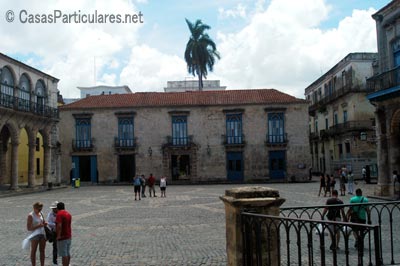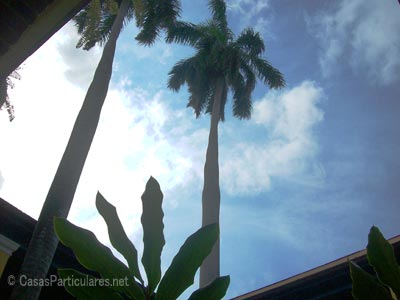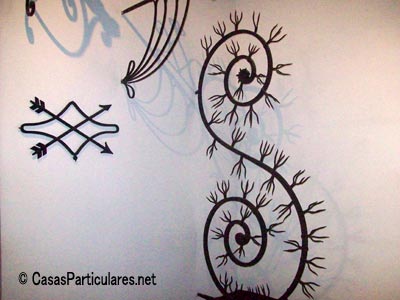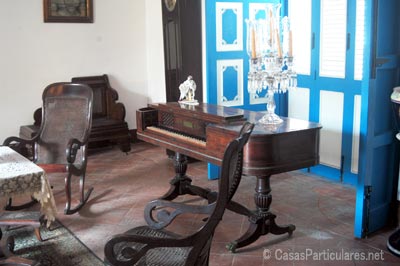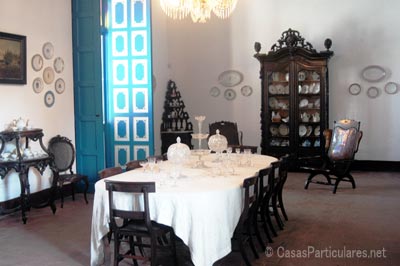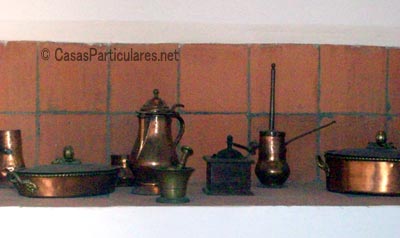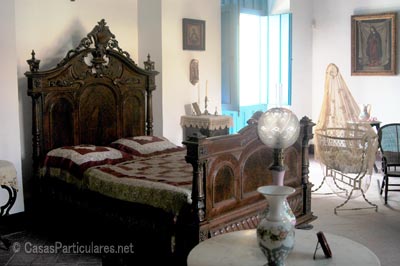The Museum of Colonial Art or Count Casa Bayona
By Luís Suárez, student in journalism, first original paragraph and translation by Danil Ren.
When the Building if Part of the Museum Itself
Yes, the building seems to be more important that what it contains. The Museum of Colonial Art, as the name suggests, has the goal to keep and show the artistic, cultural and decorative expression that belonged to the Cuban colonial era. In addition of that, the institution is unique, not for the purpose it has, but for the ambiance around it. Without counting the incredible palm tree in the middle of its inner patio, which provides a singular identity inside the Cathedral Plaza. The museum is just in face of the Havana Cathedral, a view interrupted only by the few sparse tables of the El Patio restaurant.
The Museum of Colonial Art is located in #61 San Ignacio street, between Empedrado and O'Reilly streets, in Ond Havana. The building exists since 1720 and it is also knows as the Count Casa Bayona's Manor.
From its inception the block served as several purposes, up to 1969, the year where the Museum of Colonial Art was inaugurated.
Beyond the valuable collections of colonial art it exhibits, the museographic values are equally expressed in its timeless walls and in the designs of its coffered ceilings.
At the middle of this zone, declared by the UNESCO as a world heritage, we can see from the museum outside two palm trees that grew in the famous patio garden inside the house, delimited by four corridors.
As already said, two specimen of the national plant of Cuba (the palm) distinguish the building from the outside in a special manner, but also the two floors, which join together and don't let see the mezzanines in the façade wall, stand up.
Before the Museum...
As already mentioned, the ancient mansion which was transformed into the Museum of Colonial Art was built in 1720. The order for this work was given by the lieutenant-colonel Don Luis Chacón, who was the Captain-General of the Governor of Cuba between 1702 and 1713. But, it was only from 1726 that Luís Chacón began to enjoy the residence.
The famous name Count Casa Bayona which identified the building initially is due to the marriage between Luís Chacón's daughter and José de Bayona and Chacón Fernández de Córdova et Castellón, the first person who obtained the aristocratic title of count in the 1721-1759 period. As it is easy to suppose, the couple lived there being one of the most distinguished families thanks to that prestigious title.
The portal was never constructed despite of the permission obtained in 1954 and during the XIX century and the begin of the XXth, the building was the headquarter of important organizations, such as the Real College of Writers in Havana or the daily newspaper La Discusión, which was the only edition, in 1879, to publish even on Sunday.
And starting from that time, the institution also was the result of many initiatives of construction. For example, the patio in the middle and some chambers were built in the second half of the XIXth century.
In 1931, many other innovations were implemented, which were followed by less significant others, up to the point that the mansion-house-office passed through a capital restoration process, which culminated in 1969, with the inauguration of the Museum of Colonial Art as we know it today.
The Colonial Art, Well Preserved
On July 30, 1969, the Museum of Colonial Art opened its doors to the public with the mission to keep the historic and architectural inheritance of itself, as well as the colonial heritage of the Havana past.
From its thirteen exposition rooms, twelve are permanent and one is transitory, that is, it offers specific and temporary expositions, in response of some topics proposed by the museum.
The plastic, decorative and applied arts confirm the central line of its collections. This is seen through the glass windows, the furniture, the dishes and plenty of other elements which reflect the Havana aristocratic life of the XVIIIth and XIXth centuries.
Divided into thematic sections, the collections are distributed between two floors, in the first one we can find the transitory exposition room, the Room of Architecture Elements and the Cockers Room. In the second floor converge the Receiver, three rooms devoted to the furniture, the Main Salon, the Cabinet, the living-room, the Glass Window Room and the Dormitory.
The pieces introduced in the Cockers Room are the result of a fine handcrafted work made of steels and leathers, they mainly cover the transportation subject during colony. In this room, a fine Calesse stands up (which is an ancient vehicle with animal traction), the mean of transportation which signified a great contribution to the social development, as well as the habitual holding of the conductors.
The Room of Architecture Elements is devoted to the architectural features from the epoch and shows many examples of interesting designs, applied to grills known as the guardavecinos (neighbors keeper). As well as nozzles, handgrips, doorknockers, keys and locks of the XVIIIth and the XIXth centuries.
The XIXth century nozzles, which belonged to the brings greater of Havana Cathedral are also kept, as well as a sculpture named Aldeana, from which we don't know the author.
In the second floor, there is the Reception hall, a sort of waiting room where visitors waited while the home owners were getting ready to receive them. The space was prepared for two people, if we keep into account that there are two chairs and a table in the middle. Other elements recreate the space like decorative porcelains form Italy, France and Germany.
Also present are the three Rooms dedicated to furniture, showcasing pieces that demonstrate the constant development of Cuban cabinetry through different periods. Some consider these rooms as if they were a single entity, as they address the same theme; however, the rooms are divided according to the century the furniture belongs to or whether they are authentically Cuban (and not imported from abroad).
The stool, a seat characteristic of Cuban peasants, belongs to that last group. Other furniture, such as wicker and American-style pieces, enrich the exhibits.
The evolution of the furniture and the glasswork in Cuba constitutes subjects of specialization and restoration in correspondence with the colonial society lifestyle.
The main Hall is a testament to the care taken in recreating the space in the style of typical living rooms found in Cuban homes of that era. An English piano will be the greatest attraction of the Cabinet, that space in colonial houses where families received trusted visitors.
Arriving at the living room, it seems that the XIXth century is still there. A large table holds the European glasswork, while the showcase, which the wood is aristocratically decorated, keeps mantles finely bordered and very ancient dishes, similar to the ones that decorate the walls.
It is precisely in the Dining Room where the majority of the dinnerware is concentrated, featuring very fine designs that demonstrate the ostentation characterizing the high social class that followed European fashions. Most of these pieces of china have the manufacturers' inscriptions engraved on them, so we can say with certainty that there are examples produced by the Spanish ceramics factory Sargadelos, the English corporation Royal Doulton, and others like Royal Limoges and the ceramics company La Cartuja de Sevilla-Pickman S.A.
It is also known that among the families who lived in Cuba alongside all that refinement were the Marquisates of Real-Proclamación and Real-Compañía, as well as the Countships of Pedroso y Garro, Sagunto, and San Ignacio. Many of the belongings of these lineages are preserved in the museum.
Beautiful stained glass windows, adapted to the most diverse designs, are visible in the room dedicated to this theme. Also noteworthy are the words of writer Alejo Carpentier that guard the room, while outlining the functionality of the stained glass and its close relationship with the sun.
The kitchen is very small, because it wasn't the original, but all the items inside are owned by the colonial past. It's said that the original kitchen was on the first floor.
In the room named "The Dormitory", we still find the furniture belonged to the San Juan de Jaruco count. There is there a corner prepared for the prayer, as well as other religious elements, or even the clothing used by women at that time.
The Museum of Colonial Art, a Must See
In order to bring new knowledge to national culture, the Museum develops a program of guided visits, instructive courses, seminaries with specialists, as well as other cultural activities.
Subordinated to the Havana Historian's Office, the Museum of Colonial Art open its doors from Tuesday to Sunday, from 9:30 AM to 5 PM.
Visiting this place is a must if we really want to know the heart of Havana and start an interesting travel through the XVIIIth and the XIXth centuries and so being updated about habits and lifestyle that predominated social life in the colonial epoch of Cuba.







